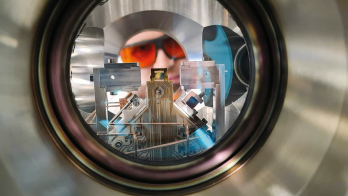CERN’s new quantum technology initiative has the potential to enrich and expand its challenging research programme, says Alberto Di Meglio.

Quantum technologies, which exploit inherent phenomena of quantum mechanics such as superposition and entanglement, have the potential to transform science and society over the next five to 10 years. This is sometimes described as the second quantum revolution, following the first that included the introduction of devices such as lasers and transistors over the past half century. Quantum technologies (QTs) require resources that are not mainstream today. During the past couple of years, dedicated support for R&D in QTs has become part of national and international research agendas, with several major initiatives underway worldwide. The time had come for CERN to engage more formally with such activities.
Following a first workshop on quantum computing in high-energy physics organised by CERN openlab in November 2018, best-effort initiatives, events and joint pilot projects have been set up at CERN to explore the interest of the community in quantum technologies (in particular quantum computing), as well as possible synergies with other research fields. In June, CERN management announced the CERN quantum technology initiative. CERN is in the unique position of having in one place the diverse set of skills and technologies – including software, computing and data science, theory, sensors, cryogenics, electronics and material science – necessary for a multidisciplinary endeavour like QT. CERN also has compelling use cases that create ideal conditions to compare classic and quantum approaches to certain applications, and has a rich network of academic and industry relations working in unique collaborations such as CERN openlab.

Today, QT is organised into four main domains. One is computing, where quantum phenomena such as superposition are used to speed up certain classes of computational problems beyond the limits achievable with classical systems. A second is quantum sensing and metrology, which exploits the high sensitivity of coherent quantum systems to design new classes of precision detectors and measurement devices. The third, quantum communication, whereby single or entangled photons and their quantum states are used to implement secure communication protocols across fibre-optic networks, or quantum memory devices able to store quantum states. The fourth domain is quantum theory, simulation and information processing, where well-controlled quantum systems are used to simulate or reproduce the behaviour of different, less accessible, many-body quantum phenomena, and relations between quantum phenomena and gravitation can be explored – a topic at the heart of CERN’s theoretical research programme. There is much overlap between these four domains, for example quantum sensors and networks can be brought together to create potentially very precise, large-scale detector systems.
Over the next three years, the quantum technology initiative will assess the potential impact of QTs on CERN and high-energy physics on the timescale of the HL-LHC and beyond. After establishing governance and operational instruments, the initiative will work to define concrete R&D objectives in the four main QT areas by the end of this year. It will also develop an international education and training programme in collaboration with leading experts, universities and industry, and identify mechanisms for knowledge sharing within the CERN Member States, the high-energy physics community, other scientific research communities and society at large. Graduate students will be selected in time for the first projects to begin in early 2021.
Joint initiatives
A number of joint collaborations are already being created across the high-energy physics community and CERN is involved in several pilot investigation projects with leading academic and research centres. On the industry side, through CERN openlab, CERN is already collaborating on quantum-related technologies with CQC, Google, IBM and Intel. The CERN quantum technology initiative will continue to forge links with industry and collaborate with the main national quantum initiatives worldwide.
Quantum technologies have the potential to transform science and society over the next five to 10 years
By taking part in this rapidly growing field, CERN not only has much to offer, but also stands to benefit directly from it. For example, QTs have strong potential in supporting the design of new sophisticated types of detectors, or in tackling the computing workloads of the physics experiments more efficiently. The CERN quantum technology initiative, by helping structure and coordinate activities with our community and the many international public and private initiatives, is a vital step to prepare for this exciting future.








